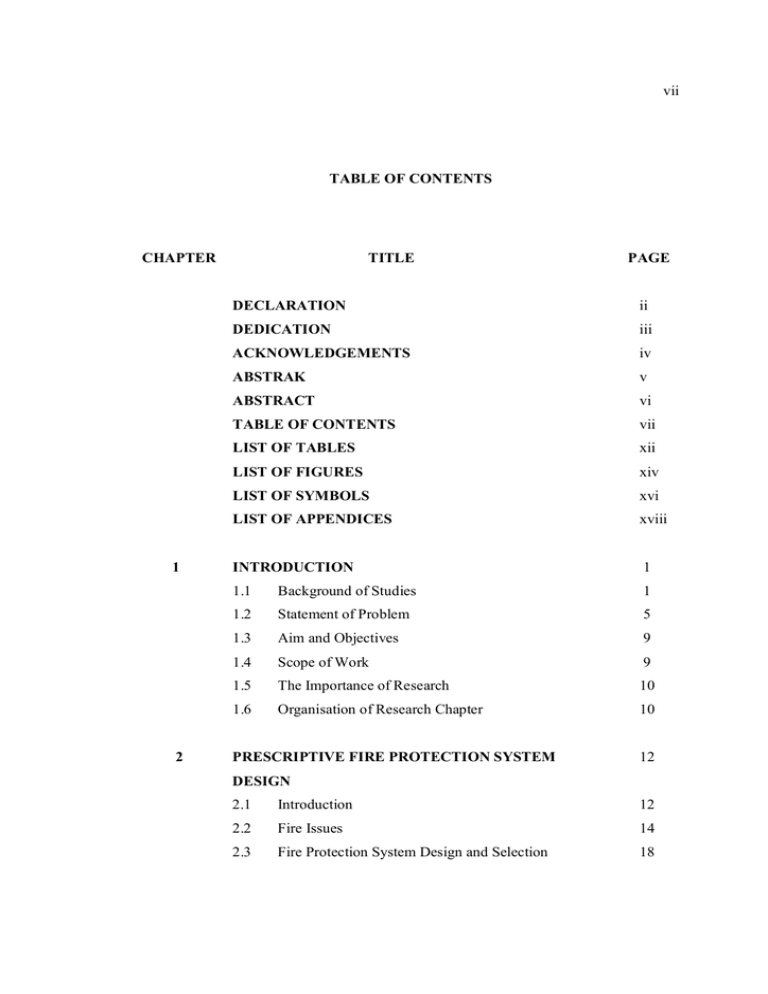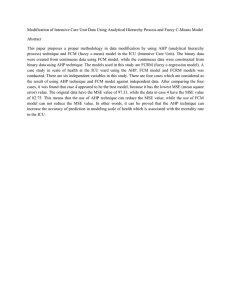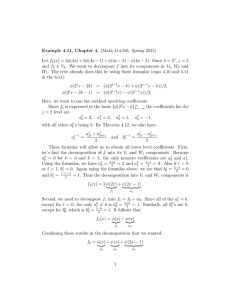vii TABLE OF CONTENTS CHAPTER
advertisement

vii TABLE OF CONTENTS CHAPTER 1 2 TITLE PAGE DECLARATION ii DEDICATION iii ACKNOWLEDGEMENTS iv ABSTRAK v ABSTRACT vi TABLE OF CONTENTS vii LIST OF TABLES xii LIST OF FIGURES xiv LIST OF SYMBOLS xvi LIST OF APPENDICES xviii INTRODUCTION 1 1.1 Background of Studies 1 1.2 Statement of Problem 5 1.3 Aim and Objectives 9 1.4 Scope of Work 9 1.5 The Importance of Research 10 1.6 Organisation of Research Chapter 10 PRESCRIPTIVE FIRE PROTECTION SYSTEM 12 DESIGN 2.1 Introduction 12 2.2 Fire Issues 14 2.3 Fire Protection System Design and Selection 18 viii 2.3.1 Reasons for Design and Installation of 25 Fire Protection 2.4 Fire Protection and Prevention Code of Practices 27 2.4.1 41 National Fire Protection Association (NFPA) Regulation Code 2.5 Fire Protection System Assessment Tools and 43 Solution 2.5.1 Fire Risk Evaluation and Cost Assessment 45 Model (FiRECAM™) 2.5.2 Fire Evaluation and Risk Assessment 49 System (FIERA System) 2.6 Active Fire Protection System 50 2.7 The Criteria/Attributes Selection of Fire Protection 53 Systems 2.7.1 Introduction on the Selection of Equipment 53 and Systems 2.7.2 The Human Side of Fire System 55 2.7.3 Fire Protection Authority Code 56 2.7.4 Design Plan and Needs 59 2.7.5 Cost of Budget 60 2.7.6 Life Safety Contribution 61 2.7.7 Ability of the Fire Protection System 62 2.7.8 Fire Protection System to Clearly Notify 63 Occupant 2.7.9 Safe Time for Occupant Evacuation Escape 2.7.10 Integration and Adaptability of Fire 64 64 Protection System 2.7.11 Means of Accessibility Fire Protection 66 System 2.7.12 Preventive Maintenance of Fire Protection 67 ix System 2.7.13 Consumer Friendly Operation of Fire 68 Protection System 2.7.14 Interior Finishes and Spaces 69 2.7.15 Fire Protection System Environment 69 Contribution 2.8 3 Summary 70 RESEARCH METHODOLOGY 71 3.1 Overview of Approach 71 3.2 Data Prerequisite 73 3.3 Data Required to Developed Fire Protection 74 System Selection 3.4 Source of Data 75 3.5 Introduction of Data Collection 76 3.6 Data Collection Technique 78 3.7 Methodology Tools for Fire Protection System 79 Selection 3.7.1 Scenario-Based Goal Decomposition 83 Approach 3.8 3.7.2 Dynamic Programming 84 3.7.3 Fuzzy Logic 86 3.7.4 Delphi Method 87 3.7.5 Analytical Hierarchy Process (AHP) 88 Data Collection Integrated with AHP Rating 89 Technique Analysis 3.9 Data Segregation and Compilation in AHP Rating 90 Technique Analysis 3.10 Generic Process Model Development 90 3.11 Evaluation and Validate Generic Process Model 90 3.12 Conclusion 91 x 4 ANALYTICAL HIERARCHY PROCESS DATA 92 ANALYSIS 4.1 Introduction to Data Analysis 92 4.2 Introduction to Analytical Hierarchy Process 93 4.3 AHP Data Analysis 94 4.4 Assembly of Data before Analytical Hierarchy Process 96 (AHP) Analysis 4.5 Organize Data in Analytical Hierarchy Process (AHP) 98 Analysis 5 4.6 Interpretation 109 4.7 Summary 109 IDEFØ MODEL AND MODELLING TECHNIQUE 110 5.1 Concept Modeling Development 110 5.2 Modelling Development 113 5.3 Layers of Model in Computer Integrated Construction 116 (CIC) 5.3.1 Specific Model 116 5.3.2 Reference Model 116 5.3.3 Conceptual Model 118 5.3.4 Metamodel 118 5.4 IDEFØ Modelling 120 5.5 IDEFØ Concepts 121 5.6 IDEFØ Syntax 122 5.7 IDEFØ Cell Modeling Graphic Representation 123 5.8 Strengths and Weaknesses of IDEF-0 124 5.9 Expected Result 126 5.10 Summary 130 xi 6 GENERIC PROCESS MODEL PERFORMANCE 132 VALIDATION 7 6.1 Introduction 132 6.2 Respondent Validation 132 6.3 Result and Recommendation 134 6.4 Concluding 138 CONCLUSION AND RECOMMENDATION 139 7.1 Statement of Conclusion 139 7.2 Future Recommendation 141 REFERENCES 142 APPENDIX - A 164 APPENDIX - B 165 xii LIST OF TABLES TABLE NO. TITLE PAGE 1.1 Large Loss Fire that Caused $10 Million or More in Property Damage, 2000-2009 3 2.1 List of Uniform Building By Laws 30 2.2 Summary of British Standards and Malaysian Standards 32 2.2.1 Fire Hydrant System 32 2.2.2 Automatic Sprinkler System 33 2.2.3 Fire Alarm System 35 2.2.4 Fire Detection System 37 2.2.5 Fire Suppression System 38 2.2.6 Standpipe Hose Reel System 39 3.1 Methodology Tools Suitability Definition 81 3.2 SWOT Scenario-Based Goal Decomposition Approach 81 3.3 SWOT Dynamic Programming 81 3.4 SWOT Fuzzy Logic 82 3.5 SWOT Delphi Method 82 3.6 SWOT Analytical Hierarchy Process (AHP) 82 4.1 Evaluation Based on Ranks of Each Factor 100 4.2 Weight of Importance 103 5.1 IDEF Family 111 xiii 6.1 Summary of Professional Respondent 128 6.2 Summary of Result and Recommendation from Professional Respondent 129 xiv LIST OF FIGURES FIGURE NO. TITLE PAGE 1.1 Direct Dollar Loss in Large-Loss Fires, Unadjusted and Adjusted 2000-2009 3 2.1 Reason When Sprinkler Are Ineffective, 2004-2008 16 2.2 Home Structure Fire Death by Smoke Alarm Performance 2003-2006 17 2.3 Building design stage and the application of fire safety requirement 18 2.4 Project Development Process – Traditional Approach 20 2.5 FiRECAM™ Flowchart 48 3.1 Fuzzy Logic Temperature Example 86 4.1 Analytical Hierarchy Process Cross Table 96 4.2 Analytical Hierarchy Process Criteria Rating Sample 98 4.3 AHP Analysis on Job Criteria Rating with Employee Alternative 99 4.4 AHP Normalize Score Formula 103 4.5 Example of Analytical Hierarchy Process Analysis (ST Integrated Engineering Sdn Bhd Respondent) 105 4.6 Importance Level and Importance Weight Combine AHP Analysis 106 4.7 Sum and Normalize Score Fire Protection System Combine Respondent AHP Analysis 107 4.8 Criteria Ranking for Combine AHP Analysis 108 xv 5.1 Abstraction Level for Meta-Model Processes 119 5.2 IDEFØ Box and Arrow Graphics 124 5.3 AHP Criteria Grouping 127 5.4 Sample of IDEF-0 Function Modelling 128 xvi LIST OF SYMBOLS NFPA – National Fire Protection Association MEP – Mechanical, Electrical and Plumbing AHP – Analytical Hierarchy Process IBC – International Building Code UBBL – Uniform Building By Law CO2 – Carbon Dioxide FEO – For Exposition Only FP – Fire Protection FIDO – Fire Incident Data Organisation FiRECAM™ – Fire Risk Evaluation and Cost Assessment Model ISO – International Organisation for Standardisation FIERA – Fire Evaluation and Risk Assessment FPEtools – Fire Protection Engineering Tools HVAC – Heat Ventilation Air Conditioning CFAST – Fire Growth and Smoke Transport Modeling HAZARD I – Fire Hazard Assessment Method BS – British Standard MS – Malaysian Standard IDEFØ – Integration Definition for Function Modeling CIC – Computer Integrated Construction SWOT – Strengths, Weakness, Opportunities and Threats MEP – Mechanical, Electrical and Plumbing SADT – Structured Analysis and Design Technique FCRC – Fire Code Reform Centre FEO – For Exposition Only PFD – Process Flow Description xvii OSTD – Object State Transition Description ICOM – Input, Control, Output and Mechanism IDEF – Integrated Definition P.E – Professional Engineer xviii LIST OF APPENDICES APPENDIX TITLE PAGE A Developed Generic Process Model 164 B AHP Data Analysis Table 165





